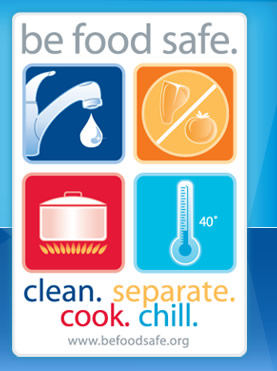Food safety has definitely been in the news lately, everything from our favorite ice creams (cfaesnews@osu.edu ) to sharing time in fellowship with a pot luck dinner (http://www.lancastereaglegazette.com/story/news/local/2015/04/21/church-picnic-botulism/26135211/ ). With all the concern, how do I make sure that I am providing safe food for my family? Here are a few tips to ensure you are doing all you can in preparing food at home for your family:
*Start with a clean kitchen, clean utensils and clean hands. Make your own sanitizing solution by adding ¾ t. bleach to 1 quart water in a spray bottle, allow to stand for several minutes, then rinse with clean water and air dry. This bleach solution can lose its effectiveness over time so discard unused portions after one week.
*Keep raw foods separate, don’t use the same utensils or plates for raw meats that you may use for cooked foods. If you take raw meat to the grill to cook, wash the plate thoroughly before placing the cooked meat back on it, or replace it with a clean one. The same idea applies to cutting boards, knives and counter space. Don’t cross contaminate foods, keep those that won’t be cooked separated from those that will.
*Cook foods to the appropriate temperatures. How do I know when they are done? By using a foodthermometer you can be sure that you are preparing foods properly without guessing. http://www.fightbac.org/storage/documents/flyers/cook_fightbac_factsheet_color_updated.pdf can give you a nice chart to hang on your cupboard door to easily refer to as you are preparing your meals. It is recommended to use your home canned foods for your family at home, not at public gatherings. Remember to boil them for 20 minutes before serving.
* Chill foods quickly and store food in shallow containers. Make sure that foods don’t sit out at room temperature for more than 2 hours and if it is really warm outside, make it only an hour. If you are grilling and using a marinade, do so in the refrigerator to keep the food safe.
If in doubt, throw it out!! Food may not show any signs of spoilage, but it’s not worth a trip to the Emergency room to find out. If you have questions, check with your local Extension Office or the National Fight Bac! food safety campaign at http://www.fightbac.org/
Author: Melinda Hill, Family and Consumer Science Educator, Ohio State University Extension, Wayne County
Reviewed by: Kate Shumaker, Family and Consumer Sciences Educator, Ohio State Univeristy Extension, Holmes County


